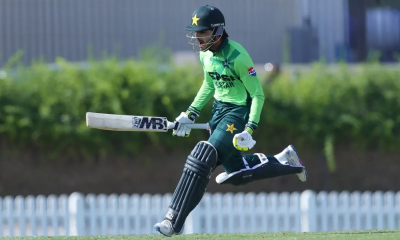Midweek Review
A deal on ECT at the Colombo harbour
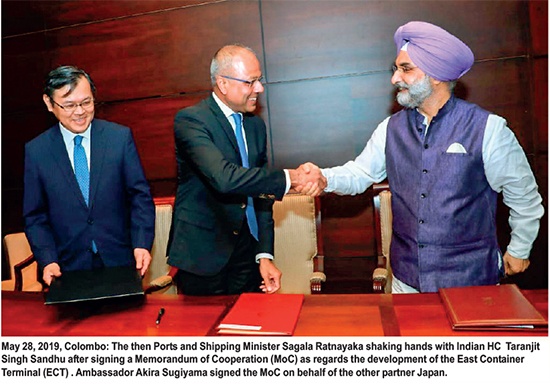
By Shamindra Ferdinando
Sri Lanka Muslim Congress (SLMC) leader Rauff Hakeem, MP, recently told The Island that Sri Lanka had no option but to involve India in the development of the deep water facility, the East Container Terminal at the Colombo Port, which has been built to accommodate the largest container ships that ply around the world carrying as many as 16,000 containers (TEUs), like its competing Chinese-run Colombo International Container Terminal also in the more recently built and what is known as the Colombo South harbour.
The Samagi Jana Balavegaya (SJB) Kandy District lawmaker said so in response to the writer seeking an explanation as regards his stand on the issue at hand in the wake of his quite controversial statement on Derana ‘Wadapitiya’, anchored by Chathura Alwis.
In response to The Island assertion that the SLMC leader took a bold but factual stand on the matter and responded: “Why beat around the bush? That is the truth.”
He hit the nail on the head, when Attorney-at-Law Hakeem declared that due to the Colombo harbour’s very heavy dependence on Indian transhipment cargo, there was no choice.
Having first entered Parliament in 1994 on the People’s Alliance (PA) National List, Hakeem took over the leadership of the SLMC soon after its founder leader M.H.M. Ashraff was killed in a helicopter crash in September 2000.
Amidst a simmering dispute over alleged Indian investment in the ECT that had engulfed the SLPP administration, Hakeem is the only lawmaker to publicly come out with the somewhat unpalatable truth that the bulk of Colombo port’s business come from Indian transhipment cargo. Hakeem, who has been in the PA, UPFA (United People’s Freedom Alliance) and the UNF (United National Front) governments as a Cabinet Minister didn’t mince his words and quite surprised the other participants, Wasantha Samarasinghe (former JVP MP and its current Anuradhapura District leader) and State Ministers, D.V. Chanaka (Hambantota District) and D.B. Herath (Kurunegala District).
Hakeem joined the programme after its commencement but lucidly explained his stand on a number of matters, including the simmering dispute over cremation of Muslim Covid-19 victims and the high profile ECT transaction. The SLMC group, within the 54-member SJB, consists of five lawmakers, including Hakeem. Hakeem recently suffered a severe setback when his four other MPs in Parliament voted for the SLPP’s 20th Amendment last October, while he alone from his party voted against it.
Besides the yahapalana regime, in which Hakeem’s SLMC was a full partner, had already muddied the Lankan waters by giving away the Hambantota Port to China on a 99-year lease. So it is only natural for New Delhi to have a foothold in Colombo with the ECT. Even our comrades, the JVP, though now making lots of noise over ECT going to the Adani Group of India, hardly murmured a word in protest when it was cavorting with the yahapalana regime at the time of the virtual sale of Hambantota to the Chinese.
The Kandy District MP, who had previously held the Ports and Shipping portfolios, said that the SLPA (Sri Lanka Ports Authority) owned JCT (Jaya Container Terminal) in addition to Unity Container Terminal. The SLMC leader emphasized the need to further develop JCT whereas CMPH (China Merchant Port Holdings) managed Colombo International Container Terminal (CICT) and Keells-led conglomerate owned South Asia Gateway Terminal (SAGT) conducted their operations successfully.
Amidst the simmering ECT issue, the former Minister declared that though some opposed foreign investment in such strategic projects, the country facing a daunting financial crisis had no option but to accept the Indian investment.
Ironically when the SLPA advertised the Colombo South Harbour for investment after it built its breakwater with a USD 300 million loan from the Asian Development Bank after the end of the war, India was not interested and for that matter no one else made any worthwhile offer other than the Chinese. However as in the case of Hambantota, New Delhi awakened to its value when the China Merchant Port Holdings singlehandedly bid and obtained the CICT berth on a 35-year Build, Operate and Transfer agreement after 2010, with the SLPA holding a mere 15 per cent stake in the venture.
Lawmaker Hakeem asserted that the situation here could be stabilized by Indian involvement in the expansion of the overall Colombo Port operations. The SJB constituent took up the position that the country was in such a desperate situation, the incumbent government couldn’t afford to antagonize India.
How Indian investments can stabilize Lanka
Hakeem took a very clear stand on ECT as well as overall foreign investment in the ports and shipping sectors. The former Ports Minister articulated that against the backdrop of foreign investment in SAGT, the first public private partnership container terminal in Sri Lanka and also CICT, there couldn’t be any issue with regard to the agreed Indian investment.
SAGT launched operations in 1999. According to the SAGT: “The Company is a Board of Investment flagship entity with approximately 60% of Sri Lankan shareholding, and is backed by John Keells Holdings, APM Terminals, SLPA and Peony investments (subsidiary of Evergreen Marine Corporation).”
State Minister Herath interrupted MP Hakeem to raise a question though the former ignored the SLPP politician.
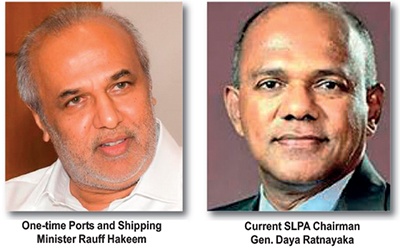 Hakeem declared that under no circumstances he would say not to accept Indian investment though the final decision lies with the incumbent government. The former Shipping Minister made reference to current Ports and Shipping Minister Rohitha Abeygunawardena declaration that 49 per cent of the ECT ownership would be foreign and the remaining 51 owned by the government. SLPA holds just 15 per cent each of SAGT and CICT. The SAGT deal is for a 30-year period on BOT (Build Operate and Transfer basis) whereas the agreement on CICT covers 35 years.
Hakeem declared that under no circumstances he would say not to accept Indian investment though the final decision lies with the incumbent government. The former Shipping Minister made reference to current Ports and Shipping Minister Rohitha Abeygunawardena declaration that 49 per cent of the ECT ownership would be foreign and the remaining 51 owned by the government. SLPA holds just 15 per cent each of SAGT and CICT. The SAGT deal is for a 30-year period on BOT (Build Operate and Transfer basis) whereas the agreement on CICT covers 35 years.
Hakeem’s stand drew opposition from all other participants, including Chathura Alwis. However, Hakeem stood firm on his stand regardless of consequences. The SLMC leader asserted that Sri Lanka couldn’t turn a blind eye to the need to appease India. Declaring that Sri Lanka had appeased India before, Hakeem, turning towards Wasantha Samarasinghe emphasized the country should come to terms with the reality.
State Minister Chanaka asked Hakeem whether the previous yahapalana government entered into a MoC (Memorandum of Cooperation) with India in respect of the ECT. Hakeem however conveniently side-stepped the query, while JVPer Samarasinghe said that was finalized in May 2019.
After having been an active team player in the much muddied yahapalana rule, MP Hakeem however had the nerve to ridicule the incumbent government’s much touted ‘neutral’ foreign policy. “I haven’t the slightest idea what this government meant by neutral or balanced foreign policy. If we took a non-aligned stand, the public can clearly understand what the government intended. How one can balance the foreign policy,” MP Hakeem said.
Hakeem silent on inter-terminal transport crisis
Trade union leader Samarasinghe alleged that one-time Ports and Shipping Minister Hakeem conveniently failed to mention the crisis caused by what the JVPer called inter-terminal transport.
Samarasinghe alleged that the inter-terminal transport was in a mess. For want of sufficient space within the harbour area, vessels couldn’t be unloaded. Samarasinghe claimed that successive governments caused unprecedented deterioration due to giving the relevant contract to immensely politically influential people outside proper tender procedures.
MP Hakeem without hesitation acknowledged the crisis within the harbour, in addition to the simmering issue over the ECT.
State Minister Herath sought MP Hakeem’s opinion on the leasing of the Hambantota Port for a period of 99 years to CMPH in late July 2017. Having been a partner to that pact, MP Hakeem naturally defended the agreement on Hambantota Port to the hilt. Hakeem had been a member of the Cabinet of the yahapalana government that finalized the controversial deal on the Hambantota Port. The then Ports and Shipping Minister Arjuna Ranatunga strongly opposed the deal. UNPer Ranatunga’s stance finally led to him being replaced by SLFPer Mahinda Samarasinghe. Ranatunga was replaced on May 22, 2017. The former national cricket Captain received the Petroleum Resources Development Ministry as a consolation prize.
Both the Minister and his brother, Dhammika objected to the deal whereas Vasudeva Nanayakkara on behalf of the Joint Opposition, moved the Supreme Court against the port transaction.
President Sirisena and Premier Wickremesinghe ensured the finalization of the controversial transaction following the delay caused by the opposition.
Panelist Samarasinghe asked Hakeem whether the yahapalana government used USD 1.2 bn received from CMPH to settle what we owed China. Warning Sri Lanka would run out of foreign reserves next year once debts were settled, MP Hakeem predicted an unprecedented financial crisis.
The SLMC leader asserted that except China all other countries were in deepening financial turmoil. The MP categorized Sri Lanka with Angola, Liberia and Lebanon. While acknowledging the economic deterioration started during the yahapalana administration, MP Hakeem faulted the incumbent government for not being able to tackle the situation.
Hakeem warned that unless the government and the Opposition worked together, the country would have to go down on its knees to international lenders as Sri Lanka had done before on many occasions. In spite of big boasts by some, those in power and others should be realistic and be aware of the challenges faced by the country. Hakeem predicted a massive tragedy. He expressed the view that against the backdrop of the incumbent government asking for foreign investments, it should be ready to consider investments in sectors preferred by those having the wherewithal. “We have to be realistic.”
Emphasizing the responsibility on the part of Sri Lanka to exploit the country’s strategic position in the East-West route on the Indian Ocean, the SLMC leader explained how the two strategic harbours in Colombo and Hambantota could be utilized.
Now that Sri Lanka had given controlling shares to one terminal at the Colombo harbour to China why not another to India, the SJB lawmaker asserted, demanding that Sri Lanka adopt a realistic approach as the country is desperately in need of foreign investment.
Subsequently, Hakeem suggested that the controlling shares of the ECT should be given to India, Japan though JVPer Samarasinghe insisted the SLPA could handle it. “With the installation of three gantry cranes, 400 m long ECT is in operation now. A further 800 m has to be built,” Samarasinghe said, asserting USD 400 mn investment was required. With the three cranes, ECT in op even now with the 440m already built, now had to build 800 m more, which required USD 400 mn.
Declaring the SAGT and CICT generated an annual income of USD 160 mn and 250 mn, respectively,
Samarasinghe asked why investors could not build a terminal in the remaining Western side. “It can be bigger than all existing facilities. Why do we have to give up lucrative ECT?”
Samarasinghe predicted in spite of claims that SLPA would receive 51 per cent and the investor 49 holding per cent, finally ECT, it too, was expected to be eventually shared in the proportion of 15 per cent to the SLPA and 85 per cent to the investor.
ECT aggravates Prez, PM dispute
The then President Maithripala Sirisena and Premier Ranil Wickremesinghe clashed over the ECT. The dispute caused rapid deterioration of yahapalana relationship in the run-up to the sacking of Wickremesinghe’s government on Oct 26, 2018. Wickremesinghe insisted on Indian investment whereas Sirisena rejected it. But, Wickremesinghe went ahead with the project regardless of the President’s intervention. Amidst deepening turmoil, Wickremesinghe brought in Japan into the picture.
On the instructions of Wickremesinghe, Sri Lanka, Japan and India signed a MoC on the ECT on May 28, 2019. According to an SLPA statement issued following the signing of the MoC, the GoSL through the SLPA retained 100% ownership of the ECT, while the Terminal Operatiing Company, is jointly owned. Sri Lanka will hold a 51 per cent-stake in the project and the joint venture partners will retain 49%.
The ECT is positioned about 3 km away from the China-funded Colombo Port City on reclaimed land on Colombo’s sea front.
“Japan is likely to provide a 40-year soft loan with a 0.1 percent interest rate,” The Hindu quoted Sudarshana Gunawardana, Director of Development Communications at the Prime Minister’s office as having said. The SLPA then termed the “envisaged Japanese loan” as “one of the best loan terms Sri Lanka has obtained”.
What is not yet clear is whether the incumbent government intends to go ahead with the MoC finalized by Wickremesinghe or change it.
JVP, SJB on ECT deal
The JVP played a significant role in paving the way for the disastrous Maithripala Sirisena presidency. The likes of trade unionist Samarasinghe have conveniently forgotten how the JVP backed UNP’s presidential candidate Sirisena, the longstanding General Secretary of the SLFP. Having installed Sirisena, the UNP-led coalition comprising one-time LTTE mouthpiece Tamil National Alliance (TNA), the JVP, the SLMC pursued an agenda of its own. One shouldn’t be surprised by lawmaker Hakeem standing as a UNP breakaway faction the SJB still followed UNP strategies though Wickremesinghe obviously had no say in its affairs.
Chief Opposition Whip Lakshman Kiriella’s recent declaration that the government should take advantage of the constitution making process undertaken by the previous yahapalana government is a case in point.
Lawmakers Kirieilla and JVP leader Anura Kumara Dissanayake recently flayed the government over the decision to involve India’s biggest ports and logistic company Adani Group in the operation. Adani Ports and Special Economic Zone Limited seems to be confident of overcoming the obstacles. The project that had been delayed due to labour protests launched ahead of the last parliamentary polls in August drew stepped up condemnation of the SJB and the JVP.
It would be pertinent to ask whether the SJB and the JVP opposed only the involvement of Adani Group in the ECT development or disputed the MoC finalized in May 2019 in the run-up to Nov 2019 presidential polls by the previous regime, in which JVP and present day SJB members were partners?
SJB heavyweight Kiriella speculated whether the government intended to win over Indian Premier Narendra Modi by giving control of the ECT to billionaire Gautam Adani. Kiriella asserted that Sri Lanka couldn’t appease India by giving ECT to a close friend of Modi. Nothing can be further from the truth.
Obviously, the SJB hasn’t taken into consideration the roles played by India and Japan as well as Australia in the overall Indo-Pacific US strategy meant to counter the growing Chinese challenge. The US led coalition is still struggling to cope up with the vastly strengthened China relentlessly pursuing an anti- China policy.
A ‘Comprehensive Partnership’ with Japan
JVP leader Dissanayake is on record as having said that a director and a local shareholder of Shangri-La who had been involved with Viyathmaga, too, promoted the deal with Adani Group. The JVPer also alleged that the same person immensely benefited from recent government decisions to change import levies on sugar and coconut oil.
Outgoing US Secretary of State Mike Pompeo’s recent visit to New Delhi and Colombo highlighted their strategy. There is no doubt the Adani Group’s move on the ECT had been approved by the highest level of political leadership and the talk of Sri Lanka trying to appease India by involving Gautam Adani is nothing but bunkum.
The public should not forget the then Premier Wickremesinghe entered into a ‘Comprehensive Partnership’ with Japan in early Oct, 2015. In the following year on Oct 09, the training squadron of the Japanese Maritime Self Defence Force (JMSDF) was in Colombo to underscore the strengthening of the partnership. The writer had an opportunity to visit JS Kashima on the invitation of the Japanese Embassy in Colombo. Asked for a clarification as regards growing Japanese military role in Asia in support of the US as well as joint military cooperation among the US, Japan and India in response to the Chinese Challenge, Commanding Officer of the squadron Rear Admiral Hidetoshi Iwasaki explained the circumstances under which the Japanese forces could be deployed overseas along with the US.
Sri Lanka-Japan ‘Comprehensive Partnership’ should be examined taking into consideration three agreements sought by the US, the ACSA (Acquisition and Cross Servicing Agreement finalized in early August 2017), stalled MCC (Millennium Challenge Corporation) Compact and SOFA (Status of Forces) agreement. The recent US declaration that Sri Lanka wouldn’t be accommodated in the MCC Compact is unlikely to be the end of the US efforts to bring Sri Lanka under its control.
As part of overall Western strategy, the US seeks a government receptive in Colombo. The US wants to deny China access to Sri Lanka. The US made an abortive bid to install the then General Sarath Fonseka as the President in January 2010. However, the US project succeeded at the January 2015 presidential election. The Sirisena-Wickremesinghe regime initially took a hardline stand on China. Some members of that administration responsible for Treasury bond scams in Feb 2015 and March 2016 alleged corruption couldn’t be tackled here unless Chinese investments were drastically pruned. Having accused China of promoting corruption here, the yahapalana administration ended up handing over the Hambantota Port on a 99-year lease to China.
In the run-up to the July 2017 Hambantota Port deal, former President Mahinda Rajapaksa accompanied by ex-External Affairs Minister and Chairman of the SLPP Prof. G.L. Peiris visited Beijing where the issue was discussed. During the weeklong visit in late 2016, they also visited Southern China. They urged the Chinese to stick to the original Hambantota development project to avert possible protests. They suggested it would be better to utilize 750 acres as originally planned. This suggestion was made against the backdrop of the then Development Strategies and International Trade Minister Malik Samarawickrema’s revelation that the Chinese wanted 15,000 acres of land in the Hambantota district for large scale development projects. In the second week of January 2017, Wickremesinghe launched the Hambantota project in spite of President Sirisrena’s objections. Wickremesinghe ignored Sirisena’s claim that the agreement hadn’t been finalized yet. Having launched the Hambantota project, Wickremesinghe declared that negotiations were underway with India and Japan for the development of the strategic Trincomalee Port.
With US-China hostility on the rise, Sri Lanka shouldn’t expect breathing space from either party. A much weaker economy as a result of the rampaging corona epidemic when compared with the time Gotabaya Rajapaksa won the presidency in Nov 2019, should prompt Sri Lanka to adopt an austerity drive.
Let that begin at the Parliament, dubbed the most corrupt institution in the country by no less a person than one-time Justice Minister Dr. Wijeyadasa Rajapaksa, PC.
Midweek Review
How massive Akuregoda defence complex was built with proceeds from sale of Galle Face land to Shangri-La

The Navy ceremonially occupied its new Headquarters (Block No. 3) at the Defence Headquarters Complex (DHQC) at Akuregoda, Battaramulla, on 09 December, 2025. On the invitation of the Commander of the Navy, Vice Admiral Kanchana Banagoda, the Deputy Minister of Defence, Major General Aruna Jayasekara (Retd) attended the event as the Chief Guest.
Among those present were Admiral of the Fleet Wasantha Karannagoda, the Defence Secretary, Air Vice Marshal Sampath Thuyacontha (Retd), Commander of the Army, Lieutenant General Lasantha Rodrigo, Commander of the Air Force, Air Marshal Bandu Edirisinghe, Inspector General of Police, Attorney-at-Law Priyantha Weerasooriya and former Navy Commanders.
With the relocation of the Navy at DHQC, the much-valued project to shift the Ministry of Defence (MoD) and Headquarters of the war-winning armed forces has been brought to a successful conclusion. The Army was the first to move in (November 2019), the MoD (May 2021), the Air Force (January 2024) and finally the Navy (in December 2025).
It would be pertinent to mention that the shifting of MoD to DHQC coincided with the 12th anniversary of bringing back the entire Northern and Eastern Provinces under the government, on 18 May, 2009. LTTE leader Velupillai Prabhakaran was killed on the following day.
The project that was launched in March 2011, two years after the eradication of the Liberation Tigers of Tamil Eelam (LTTE), suffered a severe setback, following the change of government in 2015. The utterly irresponsible and treacherous Yahapalana government halted the project. That administration transferred funds, allocated for it, to the Treasury, in the wake of massive Treasury bond scams perpetrated in February and March 2015, within weeks after the presidential election.
Maithripala Sirisena, in his capacity as the President, as well as the Minister of Defence, declared open the new Army Headquarters, at DHQC, a week before the 2019 presidential election. Built at a cost of Rs 53.3 bn, DHQC is widely believed to be the largest single construction project in the country. At the time of the relocation of the Army, the then Lt. Gen. Shavendra Silva, the former Commanding Officer of the celebrated Task Force I/58 Division, served as the Commander.
Who made the DHQC a reality? Although most government departments, ministries and armed forces headquarters, were located in Colombo, under the Colombo Master Plan of 1979, all were required to be moved to Sri Jayewardenepura, Kotte. However successive administrations couldn’t go ahead with the massive task primarily due to the conflict. DHQC would never have been a reality if not for wartime Defence Secretary Gotabaya Rajapaksa who determinedly pursued the high-profile project.
The absence of any reference to the origins of the project, as well as the significant role played by Gotabaya Rajapaksa at the just relocated Navy headquarters, prompted the writer to examine the developments related to the DHQC. The shifting of MoD, along with the Armed Forces Headquarters, was a monumental decision taken by Mahinda Rajapaksas’s government. But, all along it had been Gotabaya Rajapaksa’s determination to achieve that monumental task that displeased some within the administration, but the then Defence Secretary, a former frontline combat officer of the battle proved Gajaba Regiment, was not the type to back down or alter his strategy.
GR’s maiden official visit to DHQC
Gotabaya Rajapaksa, who made DHQC a reality, visited the sprawling building in his capacity as the President, Defence Minister and the Commander-in-Chief of the Armed Forces on the morning of 03 August, 2021. It was Gotabaya Rajapaksa’s maiden official visit to the Army Headquarters, located within the then partially completed DHQC, eight months before the eruption of the externally backed ‘Aragalaya.’ The US-Indian joint project has been exposed and post-Aragalaya developments cannot be examined without taking into consideration the role played by political parties, the Bar Association of Sri Lanka, media, as well as the weak response of the political leadership and the armed forces. Let me stress that a comprehensive probe should cover the period beginning with the Swiss project to humiliate President Gotabaya Rajapaka in November, 2019, by staging a fake abduction, and the storming of the President’s House in July 2022. How could Sri Lanka forget the despicable Swiss allegation of sexual harassment of a female local employee by government personnel, a claim proved to be a blatant lie meant to cause embarrassment to the newly elected administration..
Let me get back to the DHQC project. The war-winning Mahinda Rajapaksa government laid the foundation for the building project on 11 May, 2011, two years after Sri Lanka’s triumph over the separatist Tamil terrorist movement. The high-profile project, on a 77-acre land, at Akuregoda, Pelawatta, was meant to bring the Army, Navy, and the Air Force headquarters, and the Defence Ministry, to one location.
President Gotabaya Rajapaksa’s visit to Akuregoda would have definitely taken place much earlier, under a very different environment, if not for the eruption of the Covid-19 pandemic, just a few months after his victory at the November 2019 election. The worst post-World War II crisis that had caused devastating losses to national economies, the world over, and delivered a staggering blow to Sri Lanka, heavily dependent on tourism, garment exports and remittances by its expatriate workers.
On his arrival at the new Army headquarters, President Gotabaya Rajapaksa was welcomed by General Shavendra Silva, who also served as the Chief of Defence Staff. Thanks to the President’s predecessor, Maithripala Sirisena, the then Maj. Gen Shavendra Silva was promoted to the rank of Lt. Gen and appointed the Commander of the Army on 18 August, 2019, just three months before the presidential poll. The appointment was made in spite of strong opposition from the UNP leadership and US criticism.
President Gotabaya Rajapaksa hadn’t minced his words when he publicly acknowledged the catastrophe caused by the plunging of the national income and the daunting challenge in debt repayment, amounting to as much as USD 4 bn annually.
The decision to shift the tri-forces headquarters and the Defence Ministry (The Defence Ministry situated within the Army Headquarters premises) caused a media furor with the then Opposition UNP alleging a massive rip-off. Defence Secretary Gotabaya Rajapaksa reiterated his commitment to the project. If not for the change of government in 2015, the DHQC would have been completed during Mahinda Rajapaksa’s third term if he was allowed to contest for a third term successfully. Had that happened, Gotabaya Rajapaksa wouldn’t have emerged as the then Opposition presidential candidate at the 2019 poll. The disastrous Yahapalana administration and the overall deterioration of all political parties, represented in Parliament, and the 19th A that barred Mahinda Rajapaksa from contesting the presidential election, beyond his two terms, created an environment conducive for Gotabaya Rajapaksa’s emergence as the newly registered SLPP’s candidate.
Shangri-La move
During the 2019 presidential election campaign, SLPP candidate Gotabaya Rajapaksa strongly defended his decision to vacate the Army Headquarters, during Mahinda Rajapaksa presidency, to pave the way for the Shangri-La Hotel in Colombo. Shangri-La was among the hotels targeted by the Easter Sunday bombers – the only location targeted by two of them, including mastermind Zahran Hashim.
President Gotabaya Rajapaksa is on record as having said that vacation of the site had been in accordance with first executive President J.R. Jayewardene’s decision to move key government buildings away from Colombo to the new Capital of the country at Sri Jaywardenepura. Gotabaya Rajapaksa said so in response to the writer’s queries years ago.
Gotabaya Rajapaksa said that a despicable attempt was being made to blame him for the Army Headquarters land transaction. “I have been accused of selling the Army Headquarters land to the Chinese.”
Rajapaksa explained that Taj Samudra, too, had been built on a section of the former Army Headquarters land, previously used to accommodate officers’ quarters and the Army rugger grounds. Although President Jayewardene had wanted the Army Headquarters shifted, successive governments couldn’t do that due to the war and lack of funds, he said.
President Maithripala Sirisena and Prime Minister Ranil Wickremesinghe declared open Shangri-La Colombo on 16 November, 2017. The Hong Kong-based Shangri-La Asia invited Gotabaya Rajapaksa for dinner, the following day, after the opening of its Colombo hotel. Shangri-La Chairperson, Kuok Hui Kwong, the daughter of Robert Kuok Khoon Ean, was there to welcome Gotabaya Rajapaksa, who had cleared the way for the post-war mega tourism investment project. Among those who had been invited were former President Mahinda Rajapaksa, former External Affairs Minister Prof. G.L. Peiris, former Presidential Secretary Lalith Weeratunga, and President’s Counsel Gamini Marapana, PC.
The Cabinet granted approval for the high-profile Shangri-La project in October 2010 and the ground-breaking ceremony was held in late February 2012.
Rajapaksa said that the Shangri-La proprietor, a Chinese, ran a big operation, based in Hong Kong, Malaysia and Singapore. Another parcel of land was given to the mega ITC hotel project, also during the previous Rajapaksa administration. ITC Ratnadipa, a super-luxury hotel by India’s ITC Hotels, officially opened in Colombo on April 25, 2024
Following the change of government in January 2015, the remaining section of the Army headquarters land, too, was handed over to Shangri-La.
Gotabaya Rajapaksa emphasised that the relocation of the headquarters of the Army, Navy, and Air Force, as well as the Defence Ministry, had been part of JRJ’s overall plan. The change of government, in January 2015, had caused a serious delay in completing the project and it was proceeding at a snail’s pace, Rajapaksa said. Even Parliament was shifted to Kotte in accordance with JRJ’s overall plan, Gotabaya Rajapaksa said, explaining his move to relocate all security forces’ headquarters and Defence Ministry into one complex at Akuregoda.
Acknowledging that the Army Headquarters had been there at Galle Face for six decades, Rajapaksa asserted that the Colombo headquarters wasn’t tactically positioned.
Rajapaksa blamed the inordinate delay in the completion of the Akuregoda complex on the Treasury taking hold of specific funds allocated for the project.
Over 5,000 military workforce

Gotabaya Rajapaksa’s maiden visit to DHQC on 3 August, 2021. General
Shavendra Silva is beside him
Major General Udaya Nanayakkara had been the first Director, Project Management Unit, with overall command of approximately 5,000 tri-forces personnel assigned to carry it out. The Shangri-La transaction provided the wherewithal to implement the DHQC project though the change of government caused a major setback. Nanayakkara, who had served as the Military Spokesman, during Eelam War IV, oversaw the military deployment, whereas private contractors handled specialised work such as piling, AC, fire protection and fire detection et al. The then MLO (Military Liaison Officer) at the Defence Ministry, Maj. Gen Palitha Fernando, had laid the foundation for the project and the work was going on smoothly when the Yahapalana administration withheld funds. Political intervention delayed the project and by September 2015, Nanayakkara was replaced by Maj Gen Mahinda Ambanpola, of the Engineer Service.
In spite of President Sirisena holding the Defence portfolio, he couldn’t prevent the top UNP leadership from interfering in the DHQC project. However, the Shangri-La project had the backing of A.J.M. Muzammil, the then UNP Mayor and one of the close confidants of UNP leader Ranil Wickremesinghe. Muzammil was among those present at the ground breaking ceremony for Shangri-La held on 24th February, 2012 ,with the participation of Minister Basil Rajapaksa.
Having identified the invaluable land, where the Army Headquarters and Defence Ministry were situated, for its project, Shangri-La made its move. Those who had been aware of Shangri-La’s plans were hesitant and certainly not confident of their success. They felt fearful of Defence Secretary Rajapaksa’s reaction.
But, following swift negotiations, they finalised the agreement on 28 December, 2010. Lt. Gen. Jagath Jayasuriya was the then Commander of the Army, with his predecessor General Fonseka in government custody after having been arrested within two weeks after the conclusion of the 2010 26 January Presidential poll.
Addressing the annual Viyathmaga Convention at Golden Rose Hotel, Boralesgamuwa, on 04 March, 2017, Gotabaya Rajapaksa, perhaps for the first time publicly discussed his role in the Shangri-La project. Declaring that Sri Lanka suffered for want of, what he called, a workable formula to achieve post-war development objectives, the war veteran stressed the pivotal importance of swift and bold decision-making.
Gotabaya Rajapaksa explained how the government had acted swiftly, and decisively, to attract foreign investments though some such efforts were not successful. There couldn’t be a better example than the government finalising an agreement with Shangri-La Hotels, he declared.
Declaring that the bureaucratic red tape shouldn’t in any way be allowed to undermine investments, Rajapaksa recalled the Chairman/CEO of Shangri-La Hotels and Resorts, Robert Kuok Khoon Ean, wanting the Army Headquarters land for his Colombo project. In fact, the hotels chain, at the time, had proposed to build hotels in Colombo, Hambantota and Batticaloa, and was one of the key investors wanting to exploit Sri Lanka’s success in defeating terrorism.
“Khoon-Ean’s request for the Army Headquarters land caused a serious problem for me. It was a serious challenge. How could I shift the headquarters of the war-winning Army? The Army had been there for six decades. It had been the nerve centre of the war effort for 30 years,” said Rajapaksa, who once commanded the First Battalion of the Gajaba Regiment (1GR)
Rajapaksa went on to explain how he exploited a decision taken by the first executive president J.R. Jayewardene to shift the Army Headquarters to Battaramulla, many years back. “Within two weeks, in consultation with the Secretary to the Finance Ministry, Dr. P.B. Jayasundera, and the Board of Investment, measures were taken to finalise the transaction. The project was launched to shift the Army, Navy and Air Force headquarters to Akuregoda, Pelawatte, in accordance with JRJ’s plan.”
The Hong Kong-based group announced the purchase of 10 acres of state land, in January 2011. Shangri-La Asia Limited announced plans to invest over USD 400 mn on the 30-storeyed star class hotel with 661 rooms.
The hotel is the second property in Sri Lanka for the leading Asian hospitality group, joining Shangri-La’s Hambantota Resort & Spa, which opened in June 2016.
Rajapaksa said that the top Shangri-La executive had referred to the finalisation of their Colombo agreement to highlight the friendly way the then administration handled the investment. Shangri-La had no qualms about recommending Sri Lanka as a place for investment, Rajapaksa said.
The writer explained the move to shift the Army Headquarters and the Defence Ministry from Colombo in a lead story headlined ‘Shangri-La to push MoD, Army Hq. out of Colombo city: Army Hospital expected to be converted into a museum’ (The Island, 04 January, 2011).
Yahapalana chaos
In the wake of the January 2015 change of government, the new leadership caused chaos with the suspension of the China-funded Port City Project, a little distance away from the Shangri-La venture. Many an eyebrow was raised when the then Finance Minister Ravi Karunanayake declared, in March, 2015, that funds wouldn’t be made available to the DHQC project until the exact cost estimation of the project could be clarified.
Media quoted Karunanayake as having said “Presently, this project seems like a bottomless pit and we need to know the depth of what we are getting into. From the current state of finances, allocated for this project, it seems as if they are building a complex that’s even bigger than the Pentagon!”
The insinuating declaration was made despite them having committed the blatant first Treasury bond scam in February 2015 that shook the Sirisena-Wickremesinghe administration to its core.
In June 2016, Cabinet spokesperson, Dr. Rajitha Senaratne, announced the suspension of the Akuregoda project. Citing financial irregularities and mismanagement of funds, Dr. Senaratne alleged that all Cabinet papers on the project had been prepared according to the whims and fancies of Gotabaya Rajapaksa.
The then Minister Karunanayake spearheaded the campaign against the DHQC project alleging, in the third week of January, 2015, that Rs 13.2 billion, in an account maintained at the Taprobane branch of the Bank of Ceylon had been transferred to the Consolidated Fund of the Treasury. The matter was being investigated as the account belonged to the Ministry of Defence, he added. The Finance Minister stressed that the MoD had no right to maintain such an account in violation of regulations and, therefore, the opening of the account was being investigated. The Minister alleged that several illegal transactions, including one involving Samurdhi, had come to light. He estimated the Samurdhi transaction (now under investigation) at Rs. 4 billion.
Having undermined Shangri-La and the DHQC projects, the UNP facilitated the expansion of the hotel project by releasing additional three and half acres on a 99-year lease. During the Yahapalana administration, Dayasiri Jayasekera disclosed at a post-Cabinet press briefing how the government leased three and a half acres of land at a rate of Rs. 13.1 mn per perch whereas the previous administration agreed to Rs 6.5 mn per perch. According to Jayasekera the previous government had leased 10 acres at a rate of Rs 9.5 mn (with taxes) per perch.
The bottom line is that DHQC was built with Shangri-La funds and the initiative was Gotabaya Rajapaksa’s whose role as rock solid wartime Secretary of Defence to keep security forces supplied with whatever their requirements could never be compared with any other official during the conflict.
By Shamindra Ferdinando
Midweek Review
The Hour of the Invisible

Picking-up the pieces in the bashed Isle,
Is going to take quite a long while,
And all hands need to be united as one,
To give it even a semblance of its former self,
But the more calloused and hardy the hands,
The more suitable are they for the task,
And the hour is upon us you could say,
When those vast legions of invisible folk,
Those wasting away in humble silent toil,
Could stand up and be saluted by all,
As being the most needed persons of the land
By Lynn Ockersz
Features
Handunnetti and Colonial Shackles of English in Sri Lanka
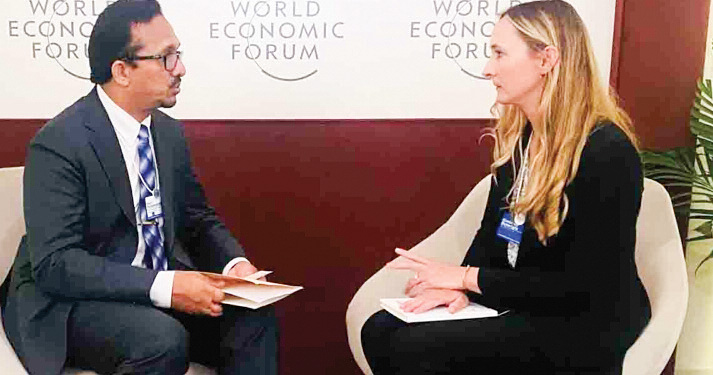
“My tongue in English chains.
I return, after a generation, to you.
I am at the end
of my Dravidic tether
hunger for you unassuaged
I falter, stumble.”
– Indian poet R. Parthasarathy
 When Minister Sunil Handunnetti addressed the World Economic Forum’s ‘Is Asia’s Century at Risk?’ discussion as part of the Annual Meeting of the New Champions 2025 in June 2025, I listened carefully both to him and the questions that were posed to him by the moderator. The subsequent trolling and extremely negative reactions to his use of English were so distasteful that I opted not to comment on it at the time. The noise that followed also meant that a meaningful conversation based on that event on the utility of learning a powerful global language and how our politics on the global stage might be carried out more successfully in that language was lost on our people and pundits, barring a few commentaries.
When Minister Sunil Handunnetti addressed the World Economic Forum’s ‘Is Asia’s Century at Risk?’ discussion as part of the Annual Meeting of the New Champions 2025 in June 2025, I listened carefully both to him and the questions that were posed to him by the moderator. The subsequent trolling and extremely negative reactions to his use of English were so distasteful that I opted not to comment on it at the time. The noise that followed also meant that a meaningful conversation based on that event on the utility of learning a powerful global language and how our politics on the global stage might be carried out more successfully in that language was lost on our people and pundits, barring a few commentaries.
Now Handunnetti has reopened the conversation, this time in Sri Lanka’s parliament in November 2025, on the utility of mastering English particularly for young entrepreneurs. In his intervention, he also makes a plea not to mock his struggle at learning English given that he comes from a background which lacked the privilege to master the language in his youth. His clear intervention makes much sense.
The same ilk that ridiculed him when he spoke at WEF is laughing at him yet again on his pronunciation, incomplete sentences, claiming that he is bringing shame to the country and so on and so forth. As usual, such loud, politically motivated and retrograde critics miss the larger picture. Many of these people are also among those who cannot hold a conversation in any of the globally accepted versions of English. Moreover, their conceit about the so-called ‘correct’ use of English seems to suggest the existence of an ideal English type when it comes to pronunciation and basic articulation. I thought of writing this commentary now in a situation when the minister himself is asking for help ‘in finding a solution’ in his parliamentary speech even though his government is not known to be amenable to critical reflection from anyone who is not a party member.
The remarks at the WEF and in Sri Lanka’s parliament are very different at a fundamental level, although both are worthy of consideration – within the realm of rationality, not in the depths of vulgar emotion and political mudslinging.
The problem with Handunnetti’s remarks at WEF was not his accent or pronunciation. After all, whatever he said could be clearly understood if listened to carefully. In that sense, his use of English fulfilled one of the most fundamental roles of language – that of communication. Its lack of finesse, as a result of the speaker being someone who does not use the language professionally or personally on a regular basis, is only natural and cannot be held against him. This said, there are many issues that his remarks flagged that were mostly drowned out by the noise of his critics.
Given that Handunnetti’s communication was clear, it also showed much that was not meant to be exposed. He simply did not respond to the questions that were posed to him. More bluntly, a Sinhala speaker can describe the intervention as yanne koheda, malle pol , which literally means, when asked ‘Where are you going?’, the answer is ‘There are coconuts in the bag’.
He spoke from a prepared text which his staff must have put together for him. However, it was far off the mark from the questions that were being directly posed to him. The issue here is that his staff appears to have not had any coordination with the forum organisers to ascertain and decide on the nature of questions that would be posed to the Minister for which answers could have been provided based on both global conditions, local situations and government policy. After all, this is a senior minister of an independent country and he has the right to know and control, when possible, what he is dealing with in an international forum.
This manner of working is fairly routine in such international fora. On the one hand, it is extremely unfortunate that his staff did not do the required homework and obviously the minister himself did not follow up, demonstrating negligence, a want for common sense, preparedness and experience among all concerned. On the other hand, the government needs to have a policy on who it sends to such events. For instance, should a minister attend a certain event, or should the government be represented by an official or consultant who can speak not only fluently, but also with authority on the subject matter. That is, such speakers need to be very familiar with the global issues concerned and not mere political rhetoric aimed at local audiences.
Other than Handunnetti, I have seen, heard and also heard of how poorly our politicians, political appointees and even officials perform at international meetings (some of which are closed door) bringing ridicule and disastrous consequences to the country. None of them are, however, held responsible.
Such reflective considerations are simple yet essential and pragmatic policy matters on how the government should work in these conditions. If this had been undertaken, the WEF event might have been better handled with better global press for the government. Nevertheless, this was not only a matter of English. For one thing, Handunnetti and his staff could have requested for the availability of simultaneous translation from Sinhala to English for which pre-knowledge of questions would have been useful. This is all too common too. At the UN General Assembly in September, President Dissanayake spoke in Sinhala and made a decent presentation.
The pertinent question is this; had Handunetti had the option of talking in Sinhala, would the interaction have been any better? That is extremely doubtful, barring the fluency of language use. This is because Handunnetti, like most other politicians past and present, are good at rhetoric but not convincing where substance is concerned, particularly when it comes to global issues. It is for this reason that such leaders need competent staff and consultants, and not mere party loyalists and yes men, which is an unfortunate situation that has engulfed the whole government.
What about the speech in parliament? Again, as in the WEF event, his presentation was crystal clear and, in this instance, contextually sensible. But he did not have to make that speech in English at all when decent simultaneous translation services were available. In so far as content was concerned, he made a sound argument considering local conditions which he knows well. The minister’s argument is about the need to ensure that young entrepreneurs be taught English so that they can deal with the world and bring investments into the country, among other things. This should actually be the norm, not only for young entrepreneurs, but for all who are interested in widening their employment and investment opportunities beyond this country and in accessing knowledge for which Sinhala and Tamil alone do not suffice.
As far as I am concerned, Handunetti’s argument is important because in parliament, it can be construed as a policy prerogative. Significantly, he asked the Minister of Education to make this possible in the educational reforms that the government is contemplating.
He went further, appealing to his detractors not to mock his struggle in learning English, and instead to become part of the solution. However, in my opinion, there is no need for the Minister to carry this chip on his shoulder. Why should the minister concern himself with being mocked for poor use of English? But there is a gap that his plea should have also addressed. What prevented him from mastering English in his youth goes far deeper than the lack of a privileged upbringing.
The fact of the matter is, the facilities that were available in schools and universities to learn English were not taken seriously and were often looked down upon as kaduwa by the political spectrum he represents and nationalist elements for whom the utilitarian value of English was not self-evident. I say this with responsibility because this was a considerable part of the reality in my time as an undergraduate and also throughout the time I taught in Sri Lanka.
Much earlier in my youth, swayed by the rhetoric of Sinhala language nationalism, my own mastery of English was also delayed even though my background is vastly different from the minister. I too was mocked, when two important schools in Kandy – Trinity College and St. Anthony’s College – refused to accept me to Grade 1 as my English was wanting. This was nearly 20 years after independence. I, however, opted to move on from the blatant discrimination, and mastered the language, although I probably had better opportunities and saw the world through a vastly different lens than the minister. If the minister’s commitment was also based on these social and political realities and the role people like him had played in negating our English language training particularly in universities, his plea would have sounded far more genuine.
If both these remarks and the contexts in which they were made say something about the way we can use English in our country, it is this: On one hand, the government needs to make sure it has a pragmatic policy in place when it sends representatives to international events which takes into account both a person’s language skills and his breadth of knowledge of the subject matter. On the other hand, it needs to find a way to ensure that English is taught to everyone successfully from kindergarten to university as a tool for inclusion, knowledge and communication and not a weapon of exclusion as is often the case.
This can only bear fruit if the failures, lapses and strengths of the country’s English language teaching efforts are taken into cognizance. Lamentably, division and discrimination are still the main emotional considerations on which English is being popularly used as the trolls of the minister’s English usage have shown. It is indeed regrettable that their small-mindedness prevents them from realizing that the Brits have long lost their long undisputed ownership over the English language along with the Empire itself. It is no longer in the hands of the colonial masters. So why allow it to be wielded by a privileged few mired in misplaced notions of elitism?
-

 Midweek Review5 days ago
Midweek Review5 days agoHow massive Akuregoda defence complex was built with proceeds from sale of Galle Face land to Shangri-La
-
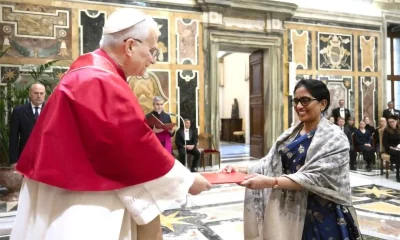
 News4 days ago
News4 days agoPope fires broadside: ‘The Holy See won’t be a silent bystander to the grave disparities, injustices, and fundamental human rights violations’
-

 News4 days ago
News4 days agoPakistan hands over 200 tonnes of humanitarian aid to Lanka
-
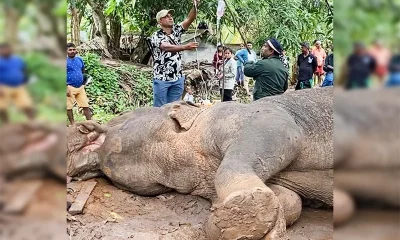
 News5 days ago
News5 days agoBurnt elephant dies after delayed rescue; activists demand arrests
-

 Business3 days ago
Business3 days agoUnlocking Sri Lanka’s hidden wealth: A $2 billion mineral opportunity awaits
-

 Editorial5 days ago
Editorial5 days agoColombo Port facing strategic neglect
-

 News3 days ago
News3 days agoArmy engineers set up new Nayaru emergency bridge
-

 News5 days ago
News5 days agoSri Lanka, Romania discuss illegal recruitment, etc.










